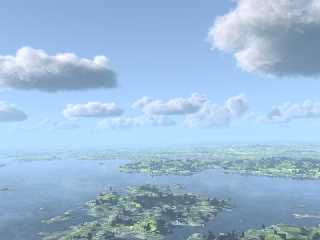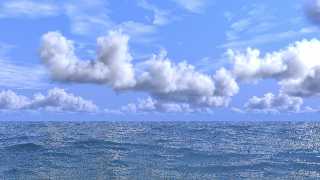 |
 |
|
 |
|
 |
|  |
|  |
|
 |
|
 |
|  |
|  |
|
 |
On 30-4-2016 18:26, Jaime Vives Piqueres wrote:
> That's strange... I'm getting good results with just 16 samples.
>
This is basically what I do; most other details are Gilles' original
settings (more or less):
#declare P_cloud2_1 =
pigment {density_file df3 "cloud2_1.df3"
lambda 3
omega 0.6
interpolate 1
translate -0.5
scale <1, -1, 1>
}
#declare Cloud1 =
box {-0.5,0.5
texture {pigment {Clear} finish {ambient 0 diffuse 0}}
hollow
interior {
media {
scattering {1, C_Sun*0.006 extinction 0.25}
intervals 1
samples 100, 1000
density {
gradient y
density_map {
[0 pigment_pattern {P_cloud2_1}
turbulence Turbulence*0.1
]
[1 pigment_pattern {P_cloud2_1}
turbulence Turbulence*2
]
}
}
}
}
scale <4/3,1,1>
}
--
Thomas
Post a reply to this message
|
 |
|  |
|  |
|
 |
|
 |
|  |
|  |
|
 |
Sorry, forgot to mention: version 3.7.1 alpha (blablabla) +av123
--
Thomas
Post a reply to this message
|
 |
|  |
|  |
|
 |
|
 |
|  |
|  |
|
 |
El 01/05/16 a las 08:52, Thomas de Groot escribió:
> scattering {1, C_Sun*0.006 extinction 0.25}
The only notable difference I see is that I'm using scattering type 2
with default extinction.
--
jaime
Post a reply to this message
|
 |
|  |
|  |
|
 |
|
 |
|  |
|  |
|
 |
On 1-5-2016 9:35, Jaime Vives Piqueres wrote:
> El 01/05/16 a las 08:52, Thomas de Groot escribió:
>> scattering {1, C_Sun*0.006 extinction 0.25}
>
> The only notable difference I see is that I'm using scattering type 2
> with default extinction.
>
The solution was straightforward (see also image):
#declare Cloud1 =
box {-0.5,0.5
texture {pigment {Clear} finish {ambient 0 diffuse 0}}
hollow
interior {
media {
scattering {1, C_Sun*0.006 extinction 0.25}
intervals 1
samples 50, 1000
density {
gradient y
density_map {
[0 pigment_pattern {P_cloud2_1}
scale 50 warp {turbulence 0.1} scale 1/50
]
[1 pigment_pattern {P_cloud2_1}
scale 50 warp {turbulence 2} scale 1/50
]
}
}
}
}
scale <4/3,1,1>
}
I shall try your scattering now.
--
Thomas
Post a reply to this message
Attachments:
Download 'my_makecloud2_test_day_2016.png' (391 KB)
Preview of image 'my_makecloud2_test_day_2016.png'

|
 |
|  |
|  |
|
 |
|
 |
|  |
|  |
|
 |
Le 16-05-01 02:52, Thomas de Groot a écrit :
> On 30-4-2016 18:26, Jaime Vives Piqueres wrote:
>> That's strange... I'm getting good results with just 16 samples.
>>
>
> This is basically what I do; most other details are Gilles' original
> settings (more or less):
>
> #declare P_cloud2_1 =
> pigment {density_file df3 "cloud2_1.df3"
> lambda 3
> omega 0.6
> interpolate 1
> translate -0.5
> scale <1, -1, 1>
> }
>
> #declare Cloud1 =
> box {-0.5,0.5
> texture {pigment {Clear} finish {ambient 0 diffuse 0}}
> hollow
> interior {
> media {
> scattering {1, C_Sun*0.006 extinction 0.25}
> intervals 1
> samples 100, 1000
> density {
> gradient y
> density_map {
> [0 pigment_pattern {P_cloud2_1}
> turbulence Turbulence*0.1
> ]
> [1 pigment_pattern {P_cloud2_1}
> turbulence Turbulence*2
> ]
> }
> }
> }
> }
> scale <4/3,1,1>
> }
>
>
samples 100, 1000 is specific to method 1 and 2. As it is now, the 1000
is ignored.
Also, it's preferable to not set intervals at all and just use the
default of 1.
Post a reply to this message
|
 |
|  |
|  |
|
 |
|
 |
|  |
|  |
|
 |
On 1-5-2016 19:00, Alain wrote:
> samples 100, 1000 is specific to method 1 and 2. As it is now, the 1000
> is ignored.
> Also, it's preferable to not set intervals at all and just use the
> default of 1.
>
>
Yes, thanks. I know this and - as it happens - just overlooked the
second samples value.
--
Thomas
Post a reply to this message
|
 |
|  |
|  |
|
 |
|
 |
|  |
|  |
|
 |
Jaime Vives Piqueres wrote on 28/04/2016 14.44:
>> Hope one or more things here enough to get this cloud method working
>> generally.
>
> Thanks for the detailed explanation, but in this case the best
> solution was the one the other Bill P. suggested. A merge of spheres
> with same radius and placement did work pretty well, and in this case it
> doesn't matter as it is an invisible container. It still does the job of
> being a close container, and the speed up provided is even a little
> better too.
>
> --
> jaime
>
:-o
Post a reply to this message
|
 |
|  |
|  |
|
 |
|
 |
|  |
|  |
|
 |
Latest development:
+ new and improved cumulus shapes using trace() over a rough base shape.
There are 10 different clouds using 500 blob components each one.
+ added cirrus layer using a panoramic photograph of real clouds as
pattern for the media density (had to "cheat" because I could not find
any convincing pattern).
--
jaime
Post a reply to this message
Attachments:
Download 'ocean-22.jpg' (149 KB)
Preview of image 'ocean-22.jpg'

|
 |
|  |
|  |
|
 |
|
 |
|  |
|  |
|
 |
On 3-5-2016 12:38, Jaime Vives Piqueres wrote:
> Latest development:
>
> + new and improved cumulus shapes using trace() over a rough base shape.
> There are 10 different clouds using 500 blob components each one.
>
> + added cirrus layer using a panoramic photograph of real clouds as
> pattern for the media density (had to "cheat" because I could not find
> any convincing pattern).
>
Looking very good indeed... I am not entirely convinced by the cirrus
layer though.
--
Thomas
Post a reply to this message
|
 |
|  |
|  |
|
 |
|
 |
|  |
|  |
|
 |
On 03/05/16 11:38, Jaime Vives Piqueres wrote:
> Latest development:
>
> + new and improved cumulus shapes using trace() over a rough base shape.
> There are 10 different clouds using 500 blob components each one.
>
> + added cirrus layer using a panoramic photograph of real clouds as
> pattern for the media density (had to "cheat" because I could not find
> any convincing pattern).
>
> --
> jaime
Very convincing cumulus; however, I'm less sure about the cirrus. I
think that a clockwise rotation might fix that.
Having said that, excellent work
John
--
Protect the Earth
It was not given to you by your parents
You hold it in trust for your children
Post a reply to this message
|
 |
|  |
|  |
|
 |
|
 |
|  |




![]()